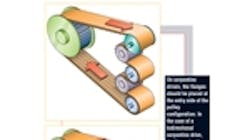Belts don’t always stay put on pulleys. Sometimes they creep to one side or another, threatening to pop off completely. This is where pulley flanges come in, steering belts back on track by resisting lateral forces. It is not necessary to have flanges on each pulley in a system; if the center distances in the drive are short, then two flanges on one pulley are usually enough to keep belt tracking straight. In some cases, it may be less costly to have two pulleys with one flange each, each being on opposite sides of the belt. Before tracking is applied, lateral belt forces should be minimized. First, all pulleys in a system should be on parallel axes. Second, belts should be uniformly pretensioned across their cords. It is generally not practical to make both of these items perfect, but attention to each make the belts easier to track.
Questions & answers
Q: What about tracking on longer stretches of belt?
A: On drives with a center distance greater than 10 times the diameter of the small pulley, additional flanged idlers may be required. It is possible to properly guide the belt with a smooth adjustable backside idler on the exiting side of the drive and a flanged pulley on the entry side of the pulley. The pulley on the exiting side can be skewed to help track the belt. This system does not function well on bidirectional drives.
Q: What are alternative tracking methods?
A: Self-tracking belts with a V-guide running on the inner surface of the belt are excellent for tracking, especially where the carrying side, or uninterrupted strand of the belt is very long. The V-guide on the belt matches a corresponding groove in the pulley and slider surface. Another method frequently employed is running the belt through an actual groove in the slider surface. The limitation here is that the belt usually needs to rise above the slider, leaving little edge area in contact for guiding. Especially in conveying applications, there are many times that flanges are not allowable on certain pulleys. This is often the case where a product is being conveyed over a pulley, and the flanges, which protrude above the carrying surface of the belt, would interfere with the product. Here, the position of the pulleys with the flanges should be carefully considered. A backside idler (which can also be used for tensioning) may help. For unidirectional travel, the flanged idler should be placed near the pulley with the belt running onto it. For bidirectional travel, the idler should be placed midway between the two pulleys.
Q: How does tracking timing belts differ from tracking other belts?
A: Tracking timing belts is inherently different than tracking flat belts. A flat belt is tracked by using a crowned pulley. This is very effective as long as the belt has some elasticity. A timing belt, however, must be inelastic; any stretch would cause the belt to elongate out of pitch so that it doesn’t mesh with the pulleys. As a result, a timing belt has to be tracked mechanically, usually through the use of flanges.
